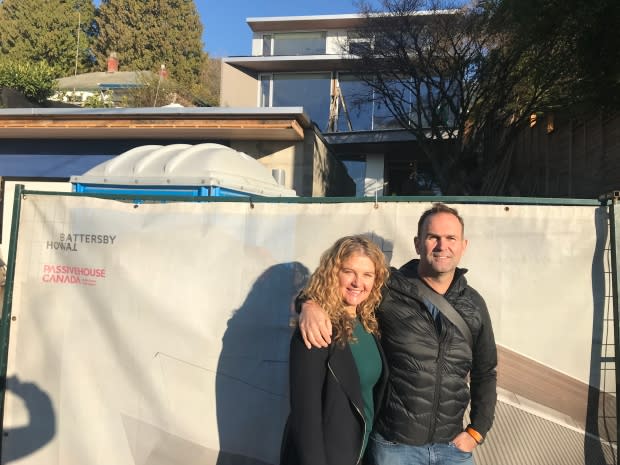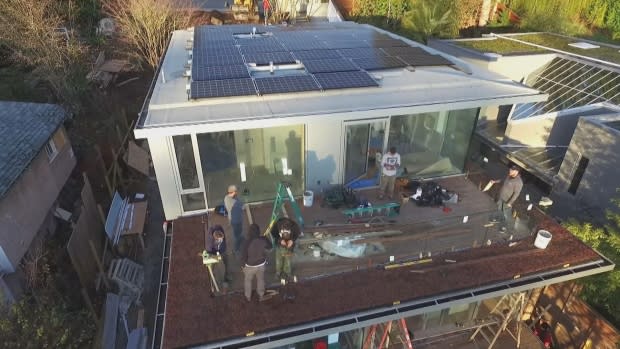How 'passive homes' are setting new green building standards, $2,000 cat door included
Sometimes being energy conscious can mean geeking out on gigawatts, or studying the latest heat exchanger technology. But in this case, it involved splurging on a $2,000 cat door.
The super-insulated, radio-frequency-controlled designer cat passageway is one of many energy saving features in a super energy efficient house being built in West Vancouver.
"I was in Austria at a passive house conference, and it was amazing seeing all these building products being built," said home owner James Dean. "One was a cat door where you needed a certain insulation level, [it] needs to be airtight, and they have an actuator that opens the door for your cat."
Dean and his wife Janet Allan shared a laugh over the pricey pet portal on a recent tour of the house.
Their nearly completed structure is what's known as a "passive house," a category designed to far exceed building codes when it comes to energy efficiency.
The pet door is just one sign of how far they were willing to go to achieve their goal.

They are hoping their family of four can have basically a zero emission lifestyle when it comes to their home and local transportation.
Solar panels, batteries, a fleet of bicycles and an electric car in the garage complete the picture.
Costing about $3 million to build, it's not far out of line in pricey West Vancouver. James said he kept close watch on the extras and said it only cost about 4 per cent more than it would have to build a similar home that meets existing building codes.
"We're going to be what's called net zero energy, so we'll generate more electricity over the year and sell it back to BC Hydro than we use," said Dean.
Passive house construction challenges
The almost finished home is perched on a hill looking over the large freighters anchored in B.C's Burrard Inlet.
It features European-made eleven foot high triple glazed windows, a high tech ventilation system, and of course, the electric cat door.
In some ways that door highlights one of the problems facing passive house proponents.
Because few are built, costs are higher for many components. For instance, the huge triple glazed windows had to be brought in from Europe because no one could supply them locally.
Some of the other touches are low tech, such as emphasis on the 40-centimetre-thick walls packed with insulation and the work to have every seam sealed.

"Putting in a more insulated and airtight envelope you really simplify the heating ventilation and air conditioning system so you reduce the amount of heating and cooling you need by 90 per cent," said Dean.
No one keeps track of how many passive houses there are across the country.
The Victoria-based organization Passive House Canada said there are at least 100 buildings that it knows of that meet the standard, including residential and commercial structures.
The group said that both Vancouver and Victoria have about one million square feet of floor space in passive buildings.
Zero emission doesn't mean super expensive
Dean's early pitch to build a passive home wasn't initially embraced by his wife, Janet Allan. She thought photos of passive houses looked dark and uninviting.
"They're very blocky with small windows, and I said our family's not going to live in a house like that. He said it doesn't have to be that way, let's build a beautiful home."
The result is bright and open. Floor to ceiling windows on one wall look out over the ocean.
Dean said going zero emission doesn't mean being super expensive, especially over the long haul.
"We'll basically pay nothing in heating and cooling for the house so we'll get that back over a number of years."
As pressure mounts to cut carbon emissions all levels of government are pushing ahead with higher energy standards. The goal is less fossil fuel fired heating across Canada.
Matt Horne is the climate policy manager for the City of Vancouver.
"The city has what's called a zero emissions building plan, and that's a roadmap out to 2030, so between 2025 and 2030, depending on the building type, all new construction would be zero emissions," Horne said.
The new Canadian standard being proposed is not as strict as passive house, and is known as "net zero ready."

Horne said in Vancouver, emissions from homes and businesses add up to about 55 per cent of the total produced, so they're a focus for those writing building codes across the country.
Costs falling for efficient homes
That worries David Foster, a spokesperson for the Canadian Home Builders Association. He said higher upfront costs might never be recovered through lower energy bills.
"We need to make sure the industry is ready, the building science is solid, the economics are there for home buyers so they can afford to get into these houses."
He points to past mistakes such as the west coast's leaky condo crisis, where thousands of units rotted due to a mix of bad design and poor building quality as an example of the need for caution before bringing in widespread changes.
Foster said currently the cost of transforming a 2,000 square foot single family home constructed from the current building code to the proposed standard of "net zero ready" is about $30,000. Net zero ready is a step below the passive house in terms of efficiency.

Foster said costs to attain the net zero ready standard have fallen 50 per cent in the last ten years.
Passive home pioneers
At the West Vancouver passive house, Shawn Barr, with Naikoon Contracting, the company building the home, said few builders are certified for this type of construction.
He said far more attention to detail is needed by all the trades involved.
"If you don't have the trades, the guys you're working with, if they're not on board and all trying to strive to the same thing, it's not going to be possible. Everybody's got to care when you're building a passive house."
The hope is builders in the upper end of the market will learn techniques that filter down to cheaper properties as building codes increasingly stress the need to reduce emissions.
Home owner Dean said it's partly about being a pioneer and showing others how to make better use of energy.
"Being the first it's always takes a bit longer, costs more money, but as more people start to do it i think the costs come down and it's going to be much more affordable."
Watch time lapse video of the passive house being built:
For Allan, it's about creating a bright and livable home their kids can be proud of.
"Our boys are really excited about it and are growing up in an environment where they're conscious of being energy efficient."

